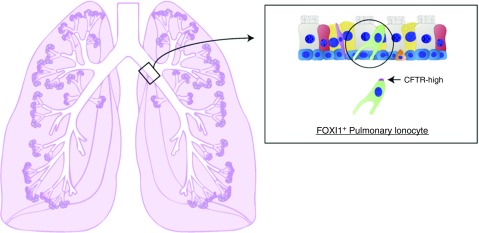Figure 1.
The discovery of the pulmonary ionocyte. The first systematic analysis of the diversity of epithelial cells lining the airways by single-cell technology was recently reported in the mouse (3). In addition to finding an unexpected diversity of club, tuft, and goblet cells in the murine airway, a new airway epithelial cell type was discovered. This novel cell type specifically expresses the transcription factor Foxi1, and its composite gene expression profile resembles those of specialized ion-transporting cells in fish gills, frog skin, and mammalian kidney. As these diverse cell types are collectively referred to as ionocytes, the new pulmonary epithelial cell has been coined a “pulmonary ionocyte.” Surprisingly, these cells also expressed the majority of Cftr (cystic fibrosis transmembrane conductance regulator gene), whose mutation causes cystic fibrosis (CF). The investigators found that deletion of Foxi1 in mice resulted in the loss of mature ionocytes and significantly altered mucus viscosity. FOXI1+ pulmonary ionocytes were also found to line the airways of human lung and express high levels of CFTR. Their role in ion transport, regulation of mucus, and high CFTR expression suggests that pulmonary ionocytes play a critical role in CF biology and disease.

